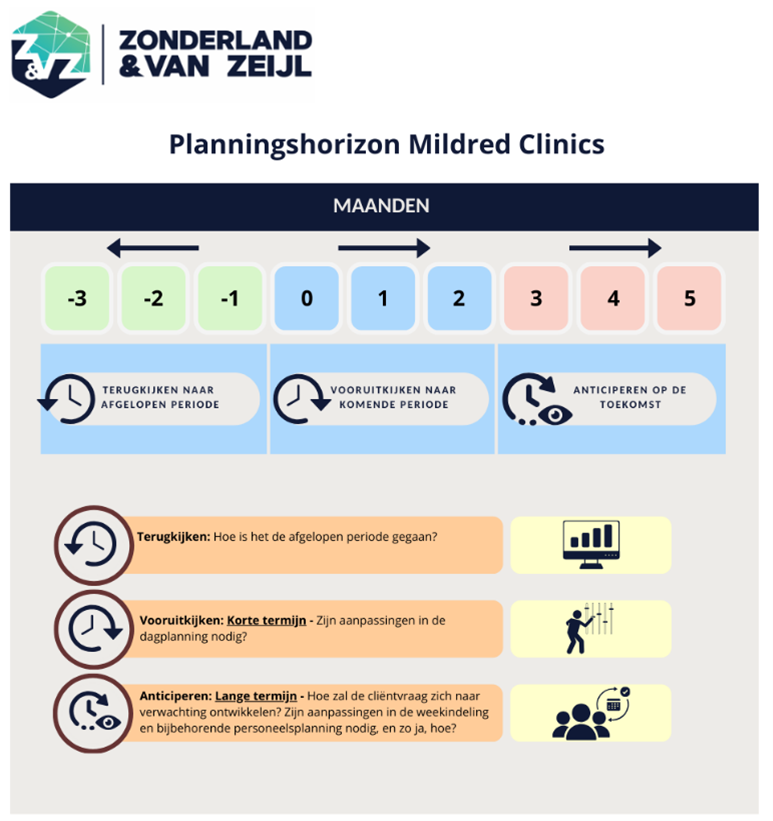BACKGROUND
Mildred Clinics is a clinic for women with unwanted or unplanned pregnancies, with locations in Arnhem, Eindhoven and 's Hertogenbosch. With their mission 'all attention for you' and years of experience, Mildred Clinics guides women who are faced with a difficult choice. They do this by listening, without judgement and by respecting every choice. If the choice is made to terminate a pregnancy, clients are guided throughout the entire process by experienced professionals. Maartje Zonderland, director at Zonderland & Van Zeijl BV, has been supporting Mildred Clinics for three years in designing planning and capacity management. Planning abortion care is a challenge because client demand fluctuates greatly. In addition, it is only clear when the client is in the clinic whether a treatment will be chosen, and if so, which one. In order to guarantee the accessibility and continuity of abortion care, it is essential to deploy employees efficiently and to continue to optimise planning.
CHALLENGE
Abortion care in the Netherlands has undergone many changes in recent years, such as the abolition of the legally required five-day reflection period, the possibility of providing the abortion pill by the general practitioner and the bankruptcy of a number of clinics. The Covid-19 pandemic has also had a major (temporary) impact on the demand for abortion care.
Mildred Clinics performs over 5,000 treatments annually. As mentioned earlier, when clients come to the clinic, it is not yet clear what the treatment process will look like. It may happen that someone does not show up for the appointment, the treatment may be cancelled or the client turns out not to be pregnant after all. In addition, there are also various treatments possible. Depending on how long someone has been pregnant, an abortion pill or curettage with or without sedation can be chosen. Based on historical data, Mildred Clinics can estimate the ratio between the various treatments, but it is not known in advance what the decision of an individual client will be. Due to the great uncertainty in client demand, the timely and efficient scheduling of employees is a challenge. In addition, anaesthesiologists are hired externally for entire half days and/or days. A well-filled sedation program is important for the efficient and cost-effective deployment of these professionals.
AANPAK
In the first six months of the collaboration between Mildred Clinics and Z&VZ, a Quick Scan was used to gain insight into how planning within Mildred Clinics was going and points for improvement were identified. Specifically, the percentage of clients who followed a certain treatment path and the predictability of this were examined.
Based on the results of the Quick Scan, Mildred Clinics started tactical planning in early 2023. This means that a Tactical Plan Meeting (TPO) takes place every three months, in which the director, medical coordinator and care coordinator of the nurses and reception, supported by Maartje Zonderland in the role of capacity advisor, discuss the following matters per location:
- Looking back at the past period (month -3 to -1): how did it go and how did the demand for abortion care develop?
- Looking ahead to the coming period (month 0 to 2): what does the near future look like? Do we still need to adjust things in the short term? Does the daily planning still suffice?
- Anticipating the future (month 3 to 5): how do we expect client demand to develop? Should we adjust the clinic's weekly schedule and associated staff planning, and if so, how?
All this is calculated using a model in which the effects of possible week and day divisions are analysed. It is also possible to calculate different scenarios with regard to the ratios between the different types of treatments. The starting points here are good accessibility of abortion care and efficient deployment of staff and anaesthesiologists.
RESULT
The establishment of the TPO and the associated quantitative approach has ensured that Mildred Clinics is increasingly 'in control' of the planning process and is not faced with surprises afterwards. Financial predictability has also increased. The periodic evaluation of the previous period in the TPO also ensures that changes in client demand are quickly noticed, such as the recent decrease in the number of no-shows. This can then be anticipated immediately.
<




